Orissa, state in eastern India, bordered on the north by Bihâr state and West Bengal state, on the east by the Bay of Bengal, on the south by Andhra Pradesh state, and on the west by Madhya Pradesh state. Orissa covers an area of 155,782 sq km (60,148) sq mi.
The coastline is largely smooth and lacks good ports. The coastal strip is narrow, level, and extremely fertile. Other natural regions in Orissa include the inland northern plateau and the Eastern Ghats. Orissa's climate is warm, with average December temperatures ranging from 16° to 28° C (61° to 82° F). In May the average temperatures range from 27° to 38° C (81° to 100° F). The state's average annual rainfall is about 1800 mm (about 70 in), with most rain falling in the north and over the Eastern Ghats.
At the 1991 census Orissa had a population of 31,659,736, with an average density of 203 persons per sq km (526 per sq mi). Bhubaneshwar is the capital. The population of Orissa consists mainly of Oriya-speaking people, although Munda and Dravidian languages are also spoken. The overwhelming majority of residents are Hindu, but there are small minorities of Christians and Muslims. Important Hindu temples located in Orissa include Jagannath Temple in Puri and Sun Temple in Konarak. In 1991, 49 percent of the population was literate. Universities located in Orissa include Brahmapur University (founded in 1967) in Brahmapur, Orissa University of Agriculture and Technology (1962) in Bhubaneshwar, and Utkal University (1943), also in Bhubaneshwar.
Orissa's economy is predominantly agricultural with most of the population engaged in raising rice. Other agricultural products are pulses (legumes), cotton, tobacco, sugarcane, and turmeric. Among the livestock raised are buffalo and other cattle, sheep, and goats. Fish is largely exported. Industries include the production of pig iron and steel, the manufacture of textiles, cement, paper, glass, aluminum, flour, and soap, and the processing of sugar and oil. Hand-loom weaving and the making of baskets, wooden articles, hats, nets, and silver filigree (ornamental work) are carried on.
Orissa has a single-chamber legislative assembly with 147 seats. The state sends 31 members to the Indian national parliament: 10 to the Rajya Sabha (Upper House) and 21 to the Lok Sabha (Lower House). Local government is based on 27 districts. Orissa came under British control in 1803. In 1912 it was united as a province with Bihâr, but it became a separate province in 1936. In 1949 it became a state, with the addition of some small native states.
| State Capital | Bhubaneswar |
| Population ('000s in 1991) | 31,660 |
| Area ('000 sq. km) | 156 |
| Females per 1000 males (1991) | 971 |
| Literacy rate (1991) | 49.1 |
| Ratio of urban population (1991) | 13.4 |
| Net Domestic Product (Rs. million at current prices in 1992-93) |
129,220 |
| Per Capita Income (Rs. at current prices 1992-93) |
3,963 |
| Principal Language | Oriya |
The ancient capital of the Kalinga empire, and now the capital of Orissa, Bhubaneswar's history goes back over 2000 years. "Bhubaneshwar" means the "abode of God" or "master of the universe" and it was also, once known as the 'Cathedral of the East', on account of the large number of shrines. At one time, the Bindu Sagar tank was bordered by over 7000 temples. Of these, 500 still survive, all built in the extravagant Oriya style. It is of these temples, that the great poet, Rabindranath Tagore had once said - 'At all places where the eye rests, and also at places where the eye does not rest, the busy chisel of the artist has worked incessantly. The abode of god has been enveloped by a variety of figures depicting the good and the evil, the great as well as the insignificant, the daily occurences of human life....'
Lingaraj
Temple,
 This
most magnificent monument is also the loftiest. It dates back to the 11th
century and represents the mature and complex 'Nagara' style of Orissan
temple architecture. Its tower, dominating the surroundings, is visible
from miles around. The temple, set in a huge walled compound measuring
520 feet by 465 feet, originally consisted only of the sanctum and the
mandap or the entrance hall. The dancing hall and the hall of offerings
are later additions. Around the main shrine there are many smaller
votive shrines. The outer walls of the temple are lavishly decorated
with beautiful sculptures which mark a climax of Hindu decorative
architecture. Birds, beasts, creepers, flowers, men and women in erotic
poses and postures, a host of gods and goddesses all are there in their
full majesty and grandeur. The inner walls of the shrine, containing the
phallus symbol of Shiva, are plain and without any embellishment. Just
north of this temple is the sacred lake of Bindu Sagar with a tiny
island in the centre, where there are many lesser shrines. Here, once in
a year, Lingaraj himself is brought for ritual ablutions.
This
most magnificent monument is also the loftiest. It dates back to the 11th
century and represents the mature and complex 'Nagara' style of Orissan
temple architecture. Its tower, dominating the surroundings, is visible
from miles around. The temple, set in a huge walled compound measuring
520 feet by 465 feet, originally consisted only of the sanctum and the
mandap or the entrance hall. The dancing hall and the hall of offerings
are later additions. Around the main shrine there are many smaller
votive shrines. The outer walls of the temple are lavishly decorated
with beautiful sculptures which mark a climax of Hindu decorative
architecture. Birds, beasts, creepers, flowers, men and women in erotic
poses and postures, a host of gods and goddesses all are there in their
full majesty and grandeur. The inner walls of the shrine, containing the
phallus symbol of Shiva, are plain and without any embellishment. Just
north of this temple is the sacred lake of Bindu Sagar with a tiny
island in the centre, where there are many lesser shrines. Here, once in
a year, Lingaraj himself is brought for ritual ablutions.
These temples epitomize a comprehensive history of the Orissan style of temple architecture from its very inception to perfection spreading almost to two thousand years from 3rd century B. C. to 16th Century A. D. These magnificent monuments dominating the city skyline, are within a reasonable walking distance from one another. The 46 metre high Lingaraj Temple marks the culmination of temple tradition of Bhubaneswar.
Rajarani
Temple :  This
temple with its sculptural excellence, profuse decoration and wonderful
proportions, is a unique example of Orissan temple art. The erotic
mithuna figures, fascinating nayikas, nymphs and gaja-simhas, all are
there in great details. Its plain but majestic jagmohan (mondap)
presents a great contrast to its lavishly decorated main shrine.
This
temple with its sculptural excellence, profuse decoration and wonderful
proportions, is a unique example of Orissan temple art. The erotic
mithuna figures, fascinating nayikas, nymphs and gaja-simhas, all are
there in great details. Its plain but majestic jagmohan (mondap)
presents a great contrast to its lavishly decorated main shrine.
Other temples worth a visit include Luxmaneswar, Satrughaneswar and Bharteswar (6th century A. D.), Parsurameswar and Swarna Jaleswar (7th century), Vaital (8th century), Mukteswar (10th century), Brahmeswar (11th Century) and Anant Basudeva (13th century).
The Anant Basudeva Temple, built in 1278, is the only temple dedicated to Vaishnava worship, standing on an ornate platform, continues the decorative and mature Lingaraj temple tradition. Brahmeswar temple built in 1060, with its most elegant sculptures, is a miniature version of the great Lingaraj shrine. It is open to all including foreigners, and is a must for the visitors who care to have an idea of Orissan temple architecture.
Mukteswar Temple, with its elaborately ornate and famous torana or stone arch at the entrance, is profusely decorated on its outer walls. These embellishments include celestial beings, armed processions, and amorous figures. It is regarded a gem of Orissan architecture on a account of its exquisite carved details and lavish sculptures. The nearby Parsurameswar Temple has equally excellent carvings and sculptures on its walls. It is most noted for its latticed windows, one of which is embellished with a relief of gay dancers and musicians of great charm. It is one of the earliest and the best preserved Orissan temples.
Museums :Bhubaneswar also has three very interesting museums. The Orissan State Museum is centrally located and has a rich collection of sculptures, coins, copper plates, armory objects, rare palm leaf manuscripts, lithic and bronze age implements, paintings, traditional folk and musical instruments and other art objects. The Handicrafts Museum on the Secretariat Road houses a good collection of Orissan handicrafts.The Tribal Research Museum is another interesting place.
The crowning glory of Oriya temple architecture, the 13th century Sun temple also known as ' the Black Pagoda', comes with a baggage of centuries - old myths and legends. Legends say that Samba, the son of Lord Krishna, was afflicted by leprosy, brought about by his father's curse on him. After 12 years of penance, he was cured by Surya, the Sun God, in whose honour he built this temple.
The Sun Temple
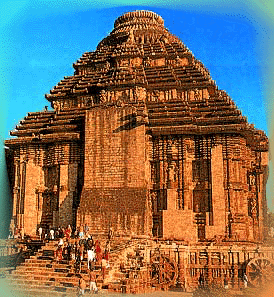
Built by Raja Narsimhadeva of the Ganga dynasty, in the 13th century AD, the temple is a pageant of human grandeur, in its perception, and in the execution of even the finest details. It resembles a colossal chariot, with 24 wheels, pulled by seven straining horses, and has a three-tiered pyramidal roof topped off by a fine spire. The Sun - God's chariot, also represents the seven days of the week, and the 24 hours of the day, in its concept. The temple is a brilliant chronicle in stone, with impressive sculptures. Every aspect of life is represented here, and the erotic imagery, depicts the sublimation of human love manifested in countless forms. Scenes from court, civic life and war are also done with great precision.
 Unlike
the other temples of the Bhubaneswar-Konark-Puri region, the Konark
temple had two smaller outer halls, completely separate from the main
structure. The assembly-hall and the tower were built on an imposing
platform, which were carved into meticulously crafted twelve pairs of
decorated wheels, each 10 feet in diameter. The entrance is reached by a
broad flight of steps, flanked on either side by prancing horses, the
whole representing the chariot, in which the Sun-God rides across the
heavens. The court of the temple, was decorated with large free-standing
sculptures of great strength and beauty. Now protected under the World
Heritage List, the temple's interior was filled - up in 1903 A.D., by
the then British Lt. Governor of Bengal, to save it from deterioration.
Unlike
the other temples of the Bhubaneswar-Konark-Puri region, the Konark
temple had two smaller outer halls, completely separate from the main
structure. The assembly-hall and the tower were built on an imposing
platform, which were carved into meticulously crafted twelve pairs of
decorated wheels, each 10 feet in diameter. The entrance is reached by a
broad flight of steps, flanked on either side by prancing horses, the
whole representing the chariot, in which the Sun-God rides across the
heavens. The court of the temple, was decorated with large free-standing
sculptures of great strength and beauty. Now protected under the World
Heritage List, the temple's interior was filled - up in 1903 A.D., by
the then British Lt. Governor of Bengal, to save it from deterioration.

One of the four holiest places in India, Puri is washed by the sea, and embraced by causarina - fringed beaches. It is said that one obtains 'moksha' from the cycle of birth and rebirth, if one stays here for three days and nights. Puri is the hallowed seat of Lord Jagannath (Lord of the Universe), Subhadra and Balabhadra. One of the four holy dhams of Hinduism, Puri is possibly one of the very few religious sites which combines the outdoor pleasures of sea and divine beaches with the religious sentiments of 'darshan'.
A place, known by many names over the centuries - Nilgiri, Niladri, Nilachal, Purushottam, Sankhakshetra, Srikshetra, Jagannath Dham, Jagannath Puri - Puri is dominated by two great forces, one created by God, and the other by man.
What to See
Jagannath Temple

Even before one enters Puri, this 65-metre high temple makes its presence felt. The 12th century temple built by Chodaganga, to commemorate the shifting of his capital from South to Central Orissa, stands in a compound on the Nilgiri Hill, and is surrounded by a 20 foot high wall, within which lie several smaller shrines. A traditional porch, shrine, hall of offerings and a pillared hall of dance, form the rest of this temple. The remarkable thing about this temple, since its early beginnings, is that there has been no discrimination, ever, between castes. To one end of the road, that leads to the temple is Gundicha Mandir, Lord Jagannath's summer temple, within a walled garden at the far end of Grand Road, where the deity is enshrined for a week, on a simple throne. Like the Lingaraja in Bhubaneswar, Puri's Jagannath is not open for non - Hindus, who must contend themselves, from viewing it from a vantage point, outside its precincts.
Ananda Bazar - The largest food market in the world.
Gundicha Mandir - The Garden House, the smaller sanctum, that houses the deities during the Rath Yatra. The walls enclose a garden, in which the temple is built. It is also known as the Aunt's house.
Puri Beach - Sunrise and sunset on the seas of Puri are awesome spectacles, and visitors can ride the waves in catamarans. The beaches are ideal for sunbathing.
Balighai Beach - 8 kms from Puri, is Balighai Beach, at the mouth of the river Nuanai, a popular picnic spot, fringed by lovely causarina trees.
Satyabadi (Sakshigopal) - The shrine of Lord Sakshigopal is only 20 kms away from Puri. the sacred feet of Shri Radha can however be only seen on 'Anala nawami' day.
Bada Danda - An ideal site for some extensive shopping.
Festivals
The Chandan Yatra celebrating the Hindu New Year. The Snana Yatra, celebrating Lord Jagannath's ritual bath is held on the day of the full moon in June (Jyestha). The original deities are taken out for public viewing. During the Jhulana Yatra, proxy images of the deities are carried out in grand processions for 21 days, to cruise in beautifully decorated boats in the Narmada Tank.
And, of course, the prime attraction for tourists all over India and abroad, which is, the Rath Yatra, which falls in the month of June- the ideal time to visit Puri.Lord Jagannath with his sister Subhadra and brother Balabhadra take an annual vacation to the 'Gundicha Ghar', a smaller sanctum, 2 kms from the main temple. This journey constitutes the Rath Yatra Festival. The three deities, in separate raths (wooden chariots), are pulled by devotees to the Gundicha temple. These raths are elaborately dressed in a riot of colours, the colours symbolising the significance of each deity.
Rath Yatra Festival
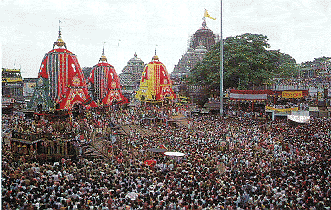 The
Rath Yatra and Nava Kalebara, are the famous festivals of Puri. Both
these events are related to the reigning deity, Lord Jagannath. The Nava
Kalebara festival is an immensely significant religious ritual, wherein
the the idols of the three deities - Jagannath, Balabhadra and Subhadra
change their external forms. New idols are carved out of specially
sanctified Chandan-Neem trees, within strictly prescribed regulations.
The 'daru' (wood) is then transported to the temple in full regalia.
The
Rath Yatra and Nava Kalebara, are the famous festivals of Puri. Both
these events are related to the reigning deity, Lord Jagannath. The Nava
Kalebara festival is an immensely significant religious ritual, wherein
the the idols of the three deities - Jagannath, Balabhadra and Subhadra
change their external forms. New idols are carved out of specially
sanctified Chandan-Neem trees, within strictly prescribed regulations.
The 'daru' (wood) is then transported to the temple in full regalia.
At this point the Vishwakarmas (wood sculptors) step in and work for 21 days and nights, in strict secrecy, giving final shape to the idols. The new idols are then enshrined after transferring the 'Brahma' within each idol into their new form. This is again done in strict accordance to the religious norms.
Puri Beach Festival is celebrated annually in early November, in Puri.Orissan craft, cuisine and cultural evenings are the highlights of the event.
Nandankanan Biological Park
The picturesque Nandankanan, or the Garden of the Gods, is a beautiful biological park, 20 kms from Bhubaneshwar, established in 1960. It sprawls across the Chandaka forest, where the flora and fauna flourish in their natural habitat. The park houses the very first captive gharial breeding centre of the country. The zoo at Nandakanan is world-renowned for its white tigers. In 1980, for the very first time, three white tiger cubs were born from normal coloured parents.
With facilities for boating, white tiger and lion safaris, a nocturnal animal house, reptile park, aerial ropeway and cable car, it is the place for a person with a penchant for the great outdoors.
Chandka Elephant Reserve
Located in Bhubaneshwar, this reserve is the ony one of its kind in India. Besides elephants, sambar, bears, wild dogs, pea fowls and pythons can be spotted.
Chilika Lake
Located at a distance of 100 km from Bhubaneshwar, this lake covering an area of 900 sq. km, is Asia's largest salt and fresh water lake. It attracts a large number of migratory birds, like the flamingo, teal, bar headed goose, shoveller and white - bellied sea eagle. For bird-lovers, Chilika is best visited in winter when the migratory populations wing in from places as far as Siberia
Close to the mouth of the lake, is a large population of Gangetic dolphins. Chilika is easily accessible from both Bhubaneshwar and Puri.
Bhitarkanika Sanctuary
Bhitarnika is an adventurist's paradise and a breeding ground for Olive Ridley turtles. The second largest mangrove forest of the country, it was declared a sanctuary in 1975, in order to protect the estuarine crocodile and the turtles in their rare mangrove habitat. Other residents of the sanctuary include water monitor lizards and king cobras.
Similipal Tiger Reserve
The Simlipal National Park, one of the earliest to come under Project Tiger, is located in the forest belt of north Orissa. It was the erstwhile hunting preserve of the Maharajas of Mayurbhanj. Simlipal, covering an area of 2,750 sq kms was declared, in 1973, as one of the nine tiger project reserves in the country. A vast tract of stately sal forests, beautiful waterfalls and grassy valleys, twelve rivers run across its expanse. It is home to panthers, tigers, gaur bison, antelopes, sambar, mouse deer - the tiniest of the deer family, mugger or crocodiles, and more than 223 species of birds.
The best time to visit is
October to early June.
How to get there: Air and rail - Jamshedpur (140 km), Bhubaneswar (350
km), Calcutta (240 km)
The nearest town is Baripada (50 km).
Accomodation is available at Forest Rest House.
Contact: Field Director, Simlipal, Project Tiger, Baripada, Orissa -
757002.
Satkosia - Baisipalli Sanctuary
Flanking the Satkosia gorge and very rich in flora and fauna, this sanctuary is famous for its Gharial breeding project. A stay here, and a trek in the 25 km long gorge, with beautiful forests on either side, is a memorable experience.
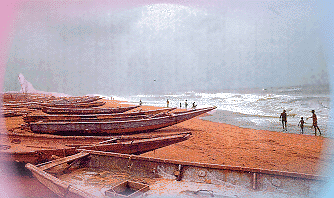
Puri Beach
Though one of India's holiest pilgrimage centres, Puri is also clebrated for its attractive coastline, that has gifted it with some very fine beaches. The beach front is wide, and ideal for beach sports. The sea at Puri can, however, be rough. Swimming, here, is recommended only in the company of life guards, who can be distinguished by their characteristic yellow conical caps. There are several resorts, that line the beaches, and range from the modest in comfort, to the more luxurious. Due to the rough sea, water sports are not common.
Gopalpur-on-Sea
Another popular beach resort is Gopalpur-on-Sea, 170 km from Bhubaneshwar, and 15 km from Berhampur. This is a perfect beach, fairly isolated, and undisturbed by day-trippers. This place is good for both sailing and surfing.
Chandipur
Another divine beach resort of Orissa, Chandipur is situated 16 kms away from Balasore. It is a unique beach in that that the sea water recedes about 5 kms during low tide and advances to the shore line again during high tide, each day.
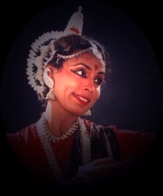
The quintessence of Odissi, is a dance form is in its sculpturesque quality. Most of its beautiful poses bear close resemblance with the sculptures of the famous temples, which once nourished the art. In Orissa, both in dance as well as in sculpture, the Bhanga (bend) concept of Hindu iconography has been fully exploited. The characteristic features of Odissi are in its deflection of the hip, poses with three body bends (Tribhanga) and archways designs of hand movements with rounded liquid body movements. This dance form has a sensuous charm. While converging the space the dancers with symmetrical patterns of rectangles, squares and circles create myriad's of fascinating visuals.


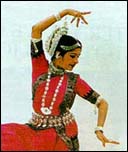
Alternate Names of Places_
-- Chakra Kshetra, Mandiramalini Sahara
Bhubaneswar
Brahmapur Berhampur --
Bhanjanagar -- Rasalkunda
Bihanga Vihar Chilika --
Daringibadi -- Kashmir of Orissa
Biraja Kshetra, Devi Kshetra Jajpur --
Sarala Pitha Jhankad --
Konark -- Arka Kshetra, Padma Kshetra, Black Pagoda
Kapilas -- Kailash of Orissa
Kendrapada -- Tulasi Kshetra
Orissa --Kalinga, Utkal
Puri -- Sri Kshetra, Nilachala Dham, Jagannath Dham, Purushottam.
Rourkela -- Ispat Nagari, Steel City
Sonepur -- Subarnapur
Some Good Orissa Links